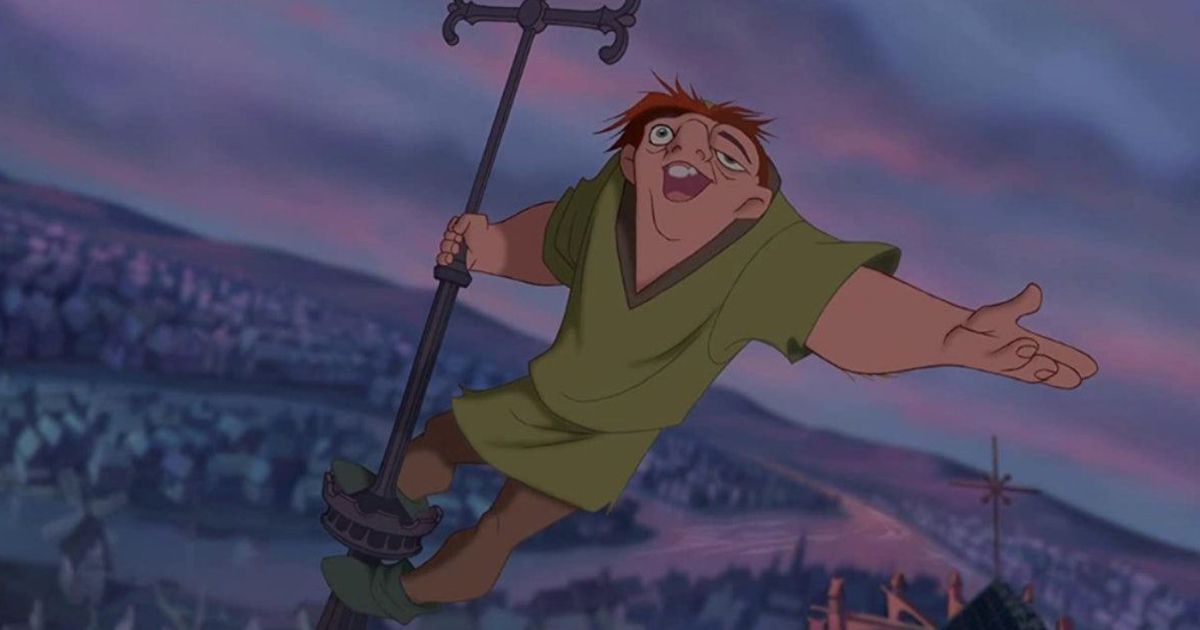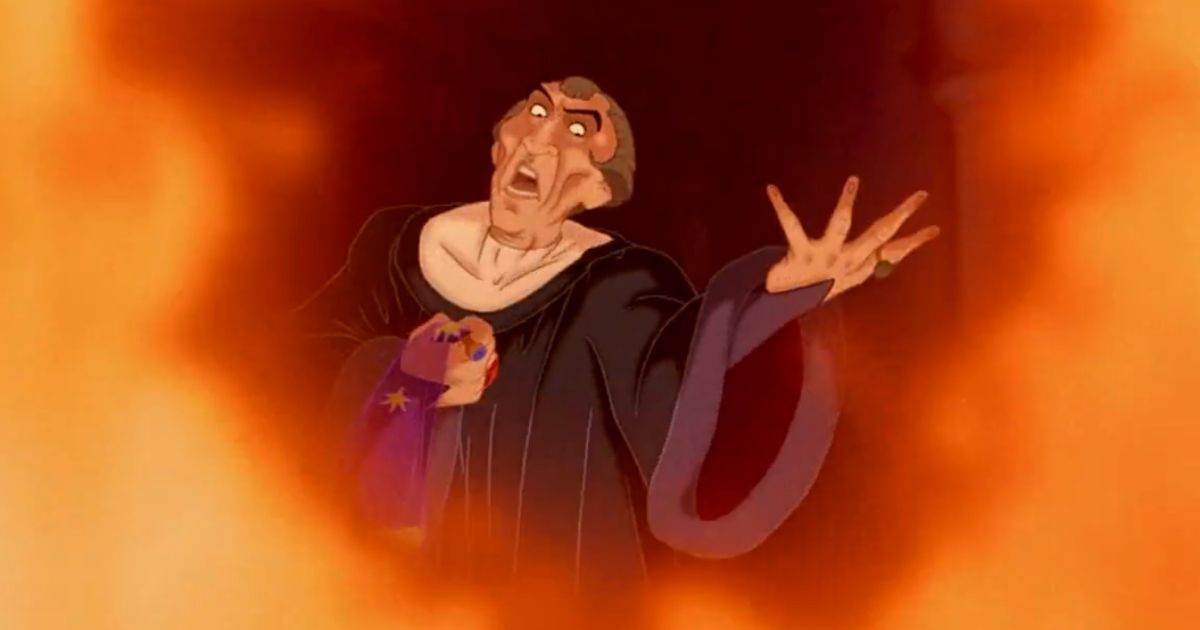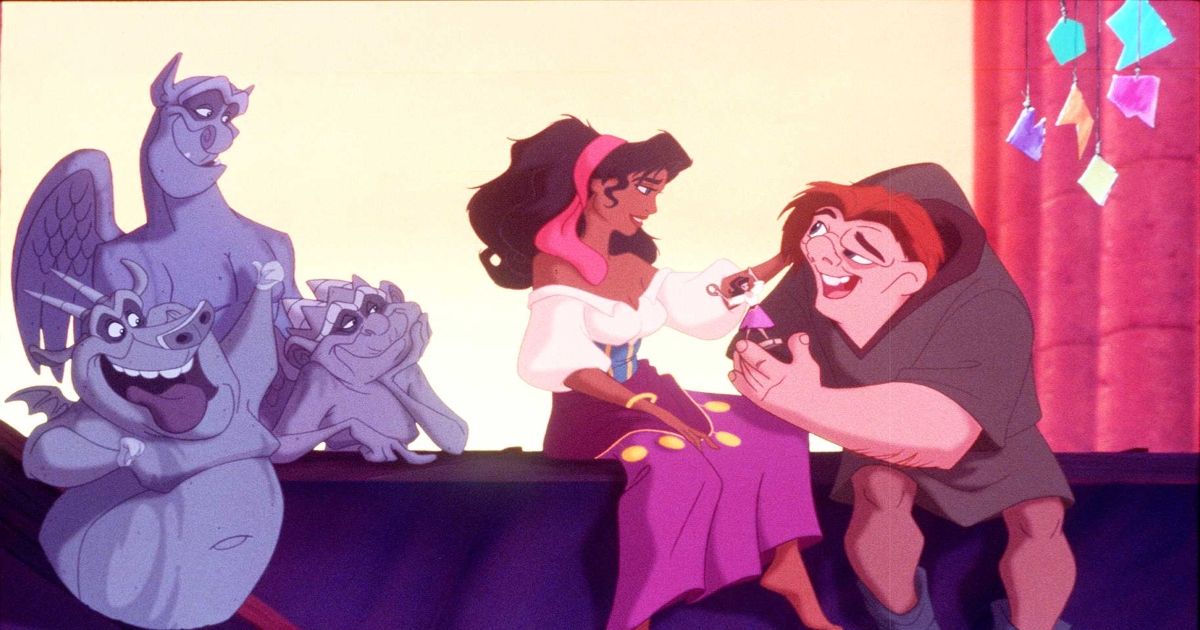The Hunchback of Notre Dame is a 1996 animated movie directed by Gary Trousdale and Kirk Wise. Loosely based on Victor Hugo’s novel, the movie follows Quasimodo (Tom Hulce), the deformed man who lives in the Notre Dame bell tower. His desire to belong to the outside world puts him at odds with evil Minister of Justice Claude Frollo (Tony Jay), and brings him into the life of Esmeralda (Demi Moore), a Romani Traveler. Quasimodo must then deal with his own feelings for Esmeralda while helping keep her and her people safe from Frollo. It was marketed as a typical, happy Disney movie, and while it was well-received, people quickly caught on that it wasn’t the light-hearted movie they’d been advertised. In fact, Hunchback is considered one of Disney’s darkest movies due to its plot and themes. Here are some of the adult themes the movie covers.
Hatred and Genocide
Hatred is one of the biggest themes in the movie. Much of this, and most of the movie’s evil, stems from Claude Frollo, who is a terrifying and deeply evil villain. He shows early hatred towards Quasimodo and wants to kill him because of his deformities. Though he keeps Quasimodo alive, he acts as an abusive father to him, keeping him confined to the bell tower and treating him horribly. This hatred for Quasimodo extends to the local people as well. When Quasimodo wants to experience the outside world, he does, only to receive tons of vicious hate. This theme of hatred becomes even more emotional when seeing Quasimodo’s heartbroken reactions to the way he is treated; watching him cry after being hit with fruit at the Feast of Fools is almost unbearably sad. Through him, the audience can truly see the effect this hatred has.
This theme of hatred continues, and when Frollo turns his hatred towards the group of Romani Travelers, it becomes genocide. Frollo wants to completely eliminate the entire Romani population from Paris. He chases them down, burns their homes, and captures the whole group with the intent of wiping them out. This kind of hatred is deeper and larger than what’s typically seen in a Disney movie; its realistic nature further adds to its depth.
Religious Corruption
As the Minister of Justice, Frollo exerts many acts of corruption that he uses his power to get away with, and uses religion to shield himself from blame. In a retrospective with the New York Times, the directors and creative team shared that they were led away from being overly religious, as “Disney did not want to take on the church.” Though this is difficult when the movie takes place in a church, they changed Frollo’s role from archdeacon in the novel to Minister in the movie. However, it’s still easy to see how he himself is corrupt in his own religious beliefs. He uses his religion as his cause to hate Quasimodo and eliminate the Romani. He also prays to be saved from his own lust, which he refuses to see as his own action. He believes himself true and righteous as a religious man, and that he can do what he pleases in the cause of that righteousness.
Sexual Desires and Manipulation
Another adult theme, and sinister aspect of Frollo’s evil, is his sexual advances toward Esmeralda. While trying to capture her, he realized that he had developed a lustful obsession for her. As if his obsession isn’t bad enough, he then blames Esmeralda for it, and sings the song “Hellfire,” where he prays for protection from Esmeralda's “spell.” It’s a dark and adult song about Frollo’s turmoil over his lust, his religion, and his hatred of the Travelers, complete with a Latin chorus and images of hellfire.
He continues hunting her, both out of a desire to capture her because she’s a Traveler, and his own sexual desires. Finally, Frollo tries to burn Esmeralda at the stake and says that she can have him, or the fire – meaning that she can be burned alive, or be spared by giving into his sexual advances, which she has always refused. Kids won’t know the deeper meaning behind it, but adults can see the sheer evil of Frollo in trying to force Esmeralda to have sex with him. It’s a dark and adult theme that further cements Frollo as Disney’s scariest villain, per ScreenRant.
Violence
Some form of violence is common in Disney movies, but Hunchback features a lot of violence, with horrible evil and cruelty behind it. From the start, we see Quasimodo’s mother seek refuge for her baby at the cathedral, only for Frollo to push her onto the stairs, killing her. He even tries to drown the baby Quasimodo, due to his appearance. Throughout the movie, Frollo engages in violence against the Romani people, and even sets fire to occupied houses. In the finale, Frollo chases Quasimodo and Esmeralda around the cathedral with swords, fully intending to kill them. In this fight, Frollo meets what is easily one of the most violent Disney villain deaths, and plunges into molten lead.
The Hunchback of Notre Dame still holds up today, with great songs and visuals. Its adult themes also remain relevant, especially for older audiences. The movie has definitely earned its reputation as one of the darkest, most mature Disney movies, and handles its mature themes well.


.jpg)

.jpg)
